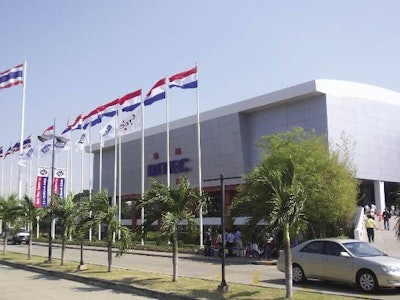
While some Asian economies may have tipped into recession, the outlook for the region as a whole is for growth of over 7% in 2009. This may be lower than in past years but it is still enviable compared to some other continents.
VIV Asia 2009, therefore, should be a bright spot compared with a number of other shows. Taking place at Bangkok International Exhibition Centre, Thailand, on March 11th-13th, the event aims to be the "region's platform for animal production and meat processing".
VIV Asia 2007 played host to 518 exhibitors from 37 countries and drew 22,000 visitors from 92 countries. Perhaps indicative of the region's growing wealth the biggest increase in visitor numbers was recorded for the Phillipines, Indonesia, Korea, Taiwan, Sri Lanka and Pakistan.
The VIV Asia 2007 edition benefited from a special theme – aquaculture. Project manager Ruwan Berculo says: "VIV Asia aims to create inspiring business platforms centred on innovation. That is why we launch special show themes."
And 2009 is no exception.
Eggs!
Mr Berculo continues that, for the coming edition, the organisers have decided to place eggs in the spotlight, reflecting the positive outlook for production and consumption of eggs and egg-related products in most Asian countries.
Egg production and processing will receive special attention this year through Eggs!, which will focus on innovations in the egg sector. Eggs! will comprise a dedicated pavilion on the exhibition floor, a conference and a CEO Forum.
The Eggs! pavilion will be an area highlighting and explaining the key issues in the egg-production chain, via an "Eggtrack". Leading companies in the sector have been invited to present their innovations. The Eggs! conference will take place on March 12th and the day will close with the CEO Forum.
An international media partnership between VIV and Watt Publsihing will ensure maximum exposure for the participants in the eggs-themed event. Watt Publishing's Frans Willem Van Beemen comments: "We are delighted with this innovative partnership between VIV and Watt to promote the Egg industry in Asia".
Feed and meat
2009's Feed and Meat Exhibition is also expected to be rich with innovations, and this will include the VIV Lane.
Mr Berculo explains: "VIV Lane is the live visualisation of all innovative topics related to the components of the feed and meat chain.
"On the show floor, it is a special alley providing a clear division between animal health, feed ingredients and additives on the one side, and housing and slaughtering on the other. We highlight special themes and topics in close collaboration with our exhibitors."
As well as the commercial aspects of the event, VIV Asia 2009 will also benefit from dedicated presentations, workshops and conferences. A key player in this part of the event will be Rabobank, the knowledge partner of VIV Worldwide, which will be highlighting current trends and topics in the Asia-Pacific region.
Rising stars
Economic growth in the region is higher than in many other parts of the world and this is feeding through into higher incomes. This increase in income is leading to improving diets and greater demand for animal protein.
Poultry meat and eggs are still the cheapest sources of animal protein. As disposable incomes rise, demand increases for poultry much faster than it does for more expensive meats.
Yet this is an area of huge contrasts. Per capita egg consumption, for example, is only 50 in India while touches 300 in China.
China may be the world's biggest consumer of poultry, but, although growing, per capita consumption remains low. Nevertheless, industrial farms are rapidly taking over from traditional methods and the sector is attracting international investment. As in much else, China is expected to have a significant impact on not only the regional poultry market, but on global production.
The region is not only important, however, in terms of consumption. Production is also growing and more sophisticated, with large-scale farms and processors working to international standards and looking to export.
In some Asian countries, there is government support for the poultry industry directed not only to help feed the local population, but also as a way of helping to capture foreign currency. And as Asian companies grow, they are not only looking to export, but are also investing overseas, taking the expertise that has been developed in their home markets and applying it elsewhere. Asia is aiming to be the "Kitchen of the World" and high on the menu will be poultry. At VIV Asia 2007, the largest number of visitors – 27.5% – came from the poultry sector, with the second highest number coming from feed mills. Across processing, feed ingredients and animal health, poultry was, again, the primary interest. VIV Asia 2009 can be expected to offer even more opportunities.


















